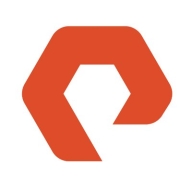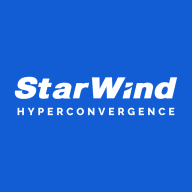


NetApp AFF and StarWind Storage Appliance are both leading storage solutions. NetApp AFF holds the upper hand in deployment ease and customer support, while StarWind Storage Appliance excels in cost efficiency and return on investment.
Features: NetApp AFF users like its high performance, reliability, and data efficiency features. StarWind Storage Appliance is preferred for its simplicity, affordability, and flexibility. While both offer valuable features, StarWind's affordability adds nuanced appeal.
Room for Improvement: NetApp AFF users mention that the product could benefit from more intuitive management tools, improved scalability options, and enhanced user interface. StarWind Storage Appliance users desire better documentation, a more refined set of features to match enterprise needs, and more robust support resources.
Ease of Deployment and Customer Service: NetApp AFF is praised for its smooth deployment process and excellent customer service. StarWind Storage Appliance is also noted for easy deployment but receives mixed reviews on customer service efficiency. NetApp AFF thus holds an edge due to consistently high service ratings.
Pricing and ROI: NetApp AFF's setup costs are generally higher, but users report satisfactory ROI due to performance gains. StarWind Storage Appliance offers lower setup costs and strong ROI, making it a cost-effective solution. Despite NetApp’s higher initial costs, both solutions present compelling ROI, with StarWind standing out in cost efficiency.
By opting for the gold subscription every three years, you get a free upgrade to the latest controller release.
If you wait more than seven years to buy another one, you get a return on your investment.
We also had one outage where a controller of one of the products had failed and had to be replaced on-site.
Customers always have their issues resolved promptly.
Pure has good storage.
The support for NetApp AFF is comprehensive—not just the documentation for self-guided reading, but for simple questions, spare parts, or urgent needs, you can have a contract that enables delivery the next business day or within four hours, depending on your process requirements.
It is highly scalable.
It is suitable for both medium-sized and enterprise businesses.
It hasn't broken down anytime in the last six to seven years, despite hurricanes, earthquakes, and power outages.
You can add more disks, more disk shelves, or migrate the data seamlessly.
During the eight years, there have been no problems such as hardware failure or stopping.
I would rate the stability of the solution as a ten out of ten.
I would rate the stability of the product at seven out of ten.
They have always been upgrading very fast and implementing patches to resolve these issues.
We would appreciate a built-in transparent failover in the next release to eliminate the need for a separate metro cluster.
I'm eagerly anticipating the roadmap's promise of introducing multiple controllers, which could significantly boost scalability and resilience.
We mostly rely on long-term releases. We don't need the most up-to-date features, but we need a reliable environment.
The GUI of ONTAP Command Manager could be better, but the CLI is perfect.
Our backup system, Commvault, has an amazing capacity to do compression and deduplication better than NetApp AFF by itself.
While the prices may be higher than those of other vendors, we see it as a market leader with benefits.
The support can be a bit pricey, but the solution is more cost-effective than anything else out there.
I would give it a nine out of ten in terms of costliness.
NetApp support is cheaper than Dell support.
While it is not cheap, they have introduced a new series of AFF that are more affordable.
Pure Storage has signature security technology, which cannot be deleted, even if you are an administrator.
The platform's robust features include excellent sustainability tracking, and a comprehensive dashboard offering insights into IOPS, bandwidth, performance, and virtual activities.
Its data compression feature is the best that we have ever seen.
You can even download the ONTAP simulator and deploy it on your virtualization platform and test almost all features.
Two important features that NetApp AFF has are the performance and the capacity to save data against attacks in general or hardware failure.



Pure Storage FlashArray//X is the world’s first enterprise-class, all-NVMe flash storage array. It represents a new class of storage – shared accelerated storage, which is a term coined by Gartner – that delivers major breakthroughs in performance, simplicity, and consolidation.
The NetApp A-Series and C-Series are AFF storage arrays that deliver high performance, scalability, and simplified data management for a wide range of workloads. They are designed for organizations that need to improve the performance and agility of their applications, while also reducing costs and complexity.
NetApp A-Series and C-Series feature a scale-out architecture that can be scaled to meet the needs of your growing business. They also support a wide range of built-in data protection and data security features, including snapshots, replication, disaster recovery, and autonomous ransomware protection.
AFF A-Series all-flash systems deliver industry-leading performance, density, scalability, security, and network connectivity.
AFF C-Series systems are suited for large-capacity deployment as an affordable way to modernize your data center to all flash and also connect to the cloud.
NetApp AFF Benefits
NetApp AFF Features
Reviews from Real Users
NetApp AFF stands out among its competitors for a number of reasons. Two major ones are its high performance and simplicity. PeerSpot users take note of the advantages of these features in their reviews:
PeerSpot user and Storage Administrator, Daniel Rúnar Friðþjófsson, comments “AFF has helped to simplify our infrastructure, while still getting very high performance for our business-critical applications. Having all these things working well on one solution is really good. We run this as the backbone for both Hyper-V and VMware as well as an archive location for Rubrik. So, it is great having one solution that can do it all.
Because of the ease of it all, you have a highly tunable, high-performance storage system that alleviates a lot of problems. With its ease of management, you can quickly get your work done and go onto the next thing on your list.”
Additionally, Mohan Reddy, Sr. Technology Architect at a Pharma/Biotech company comments on how “NetApp's ONTAP data management software has also made tasks simpler for us. There's no question about that. It has helped us run operations very quickly, saving us a lot of time. Before ONTAP, we used to spend a long time doing regular operations, but with the latest version of the tool, our day-to-day operations are much quicker and easier.”
For SMB and Enterprises who are looking for high performance primary storage for server virtualization, VDI, database and Big Data scenarios, or inexpensive secondary backup tier, our solution is StarWind Storage Appliance. It unifies commodity servers, disks and flash, and associated software into an easily scalable storage platform.
Additionally, the appliance features an optional gateway to Azure public cloud, which helps to implement an effective Disaster Recovery plan or meet regulatory requirements. StarWind SA scales up by adding individual disks and flash modules, or JBODs, while adding ready controller nodes allows scaling out.
StarWind SA targets those, who need high-performance primary storage or secondary storage for backup. In case there is a whole virtualization infrastructure to build from scratch, StarWind HCA will come in handy. Otherwise, if all the required hardware is present, StarWind Virtual SAN will be enough to build a high-performance virtualization setup.
We monitor all All-Flash Storage reviews to prevent fraudulent reviews and keep review quality high. We do not post reviews by company employees or direct competitors. We validate each review for authenticity via cross-reference with LinkedIn, and personal follow-up with the reviewer when necessary.